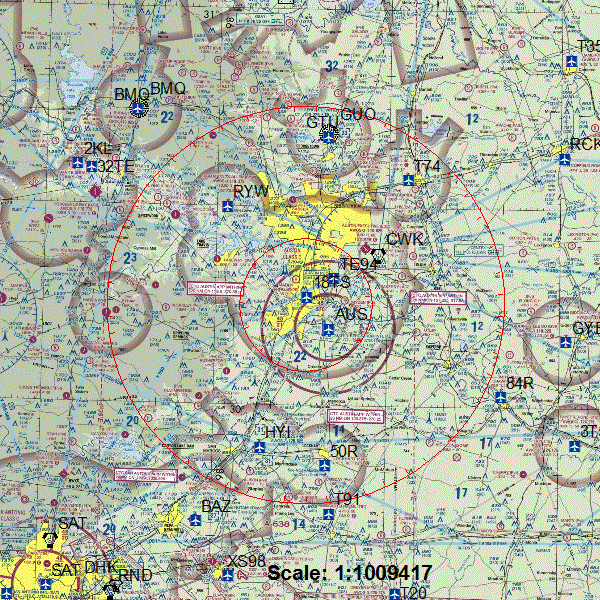The cultural hive mind known as SXSW starts this week with a massive get: President Obama. The festival, which is in its 30th year, has never hosted a sitting president. Given that 33,825 people registered for SXSW Interactive in 2015, flying a presidential entourage into a city already bursting at its seams is no easy feat. It’s going to be such a snarl that the mayor is even asking
Austinites to work from home.
Before Air Force One lands, the FAA issues a
Temporary Flight Restriction (TFR) that warns all aviation operators of the planned disruption. These notices are given for VIP movements, security threats, air shows, or other hazards.
Airlines operate centralized command centers, which usually include a dedicated FAA liaison who’s sole responsibility is to maintain consistent contact with the agency to manage any issues.
So how does technology minimize the disruption as Air Force One touches down at Austin’s Bergstrom International Airport?
Filing updated flight plans
Once a TFR has been issued, the airlines begin planning at their daily briefings. The first step is to consider the scheduled flights into and out of the airport to identify the flights most likely to be disrupted.
The next step is to then look at upstream and downstream effects: Will a delayed plane affect a connection? Should a different plane be used on a flight to be sure to minimize disruption to a future flight? Most importantly, does fuel need to be added to a flight to account for a holding pattern?

The key piece of technology here is the AirCentre
FlightPlan Manager, which automatically calculates the best route. After a flight dispatcher drops in the origin and destination, the system calculates the most efficient routing according to known TFRs and weather, as well as cost factors such as route, altitude, speed and time. For example, it might be best to delay departure to avoid congestion and wasted fuel costs. It’s also important for to avoid any restricted airspace for flights flying overhead.
FlightPlan Manager also allows dispatchers to add extra fuel, and then calculate the impact of that addition. For example, with an expected 30 minute arrival delay, the Manager calculates how much additional fuel is needed for safe arrival.
Planning for ground ops shutdown
Once Air Force One is on approach, all ground operations shut down for security purposes. This means that all crews return to the building, and no planes can be pushed away or brought into gates. The ground stop puts incoming planes into a holding pattern, creating congestion, adding cost and causing passenger frustration.
Dispatchers will turn to FlightPlan Manager to voluntarily hold a flight at its origin airport. This prevents the holding pattern issue, makes passengers less frustrated and minimizes fuel and crew costs.
AirCentre Movement Manager also springs into action, interfacing simultaneously with flight operations, aircraft maintenance and reservations personnel about all irregular operations.
Technology minimizes the disruption by accounting for these planned variables, says
FlightExplorerproduct manager Carson Marsten:
Here’s a wrench for the day. It’s about how well can plan around it. If you can communicate it well across the teams using technology, then the disruption won’t be an issue.
Minimizing disruption-related delays, cancellations and costs ultimately leads to a better traveler experience, greater satisfaction and a more profitable airline.
Preventing crew time out
Flight crews are regulated by the FAA to ensure a rested, alert crew. The crew’s first responsibility is the safety of passengers, so this is a critical regulation. However, disruptions can push crews close or over their shift limits, causing them to “time out.” Preventing crew time outs is the job of
AirCentre Crew, which considers many inputs to put crews where they need to be while complying to all local laws and aviation regulations.
There are also other factors taken into consideration by the Crew manager, including the impact that halted ground operations will have on arriving and departing flights. If an aircraft is held at the origin, and then experiences further delays as congestion over the airport unwinds, then this must be accounted for in the crew scheduling – especially if a crew may miss a tight connection.
By monitoring the various factors impacting crew movements, the software can work to get the right crew to the right flight at the right time. Without that software, flight ops specialists would be left with one heck of a complex spreadsheet!
 The key piece of technology here is the AirCentre FlightPlan Manager, which automatically calculates the best route. After a flight dispatcher drops in the origin and destination, the system calculates the most efficient routing according to known TFRs and weather, as well as cost factors such as route, altitude, speed and time. For example, it might be best to delay departure to avoid congestion and wasted fuel costs. It’s also important for to avoid any restricted airspace for flights flying overhead.
FlightPlan Manager also allows dispatchers to add extra fuel, and then calculate the impact of that addition. For example, with an expected 30 minute arrival delay, the Manager calculates how much additional fuel is needed for safe arrival.
The key piece of technology here is the AirCentre FlightPlan Manager, which automatically calculates the best route. After a flight dispatcher drops in the origin and destination, the system calculates the most efficient routing according to known TFRs and weather, as well as cost factors such as route, altitude, speed and time. For example, it might be best to delay departure to avoid congestion and wasted fuel costs. It’s also important for to avoid any restricted airspace for flights flying overhead.
FlightPlan Manager also allows dispatchers to add extra fuel, and then calculate the impact of that addition. For example, with an expected 30 minute arrival delay, the Manager calculates how much additional fuel is needed for safe arrival.







